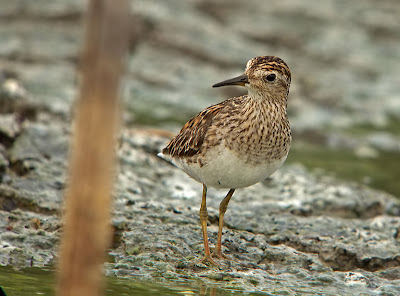Milky Stork
Benedict and I headed off to Phetchburi province this afternoon for a look at Wat Khao Takhrao and thereafter onto Laem Pak Bia to coincide with high tide. I do hope I can start many more blogs with this introduction! It was fantastic to be out birding again and it was great to have Benny with me.
There was little to suggest that we were going to run into anything interesting. The drive through Khao Yoi was unremarkable. We saw a small flock of Painted Stork as we drove through the swamp to Wat Khao Takrhao. At Wat Khao Takrhao I was prepared for a good number of Painted Stork and some Spot-billed Pelicans and I was hoping there might be some sign of Great Thick-knee.
The story however was Painted Stork, in their thousands. Impossible to count: there was a huge central core of about 1,200 birds in the middle area of the big pool and then there were smaller groups scattered everywhere. A scan revealed a pair of Spot-billed Pelicans and then Black-headed Ibis, 16 of them: quite unexpected I hasten to add. There were also a handful of Whiskered Terns and 50-60 Lesser Whistling Ducks. In terms of waders there were good numbers of Black-tailed Godwits, some Common Greenshanks, Marsh Sandpipers and Wood Sandpipers.
Asian Dowitcher
As we headed towards the temple I noticed some Godwits in one of the many pools and at this time of the year, with waders on the move, you dismiss them as a group of Black-tailed Godwits at your peril. I got a glimpse of a long, black bill with my bins and then of an incredibly strong whiter supercilium; I had the scope up in no time and all I knew was that it was neither Black-tailed nor Bar-tailed on the basis of the bill colour. I was hoping it would be a Long-billed Dowicher but that is just because I want lifers. Of course I didn't have a field guide with me so I had to get some shots of it. A call to
Tom Backlund confirmed the likelihood of it being Asian. I think the photo confirms it is indeed Asian. I wonder where this fellow has come form and I wonder where his journey will end. While I took the shot Benny did splendid work in advising the oncoming traffic to be quiet!
We then drove to Pak Thale which rather surprisingly was as good as bird-free; I must confess it is almost virtually water-free right now as most of the salt pans are empty. Strange not being able to see a Curlew or a Lesser Sand-plover. No doubt it is going to get very busy here over the next few months.
We then headed down to Laem Pak Bia. Given the near dearth of birds at Pak Thale I thought they must all be down here. Five Spot-billed Pelicans and a small group of Painted Stork and little else other than some Redshanks. Except there was a Milky Stork in the among the Painted Stork. Now this bird has been around for a few weeks so I was really pleased to connect with it and I managed to get a few shots of it.
The Milky Stork is a pretty rare bird and in fact has an
IUCN rating of Vulnerable. Its numbers are in decline with its stronghold in Sumatra, Indonesia. It pops up here infrequently usually in solitary numbers, tending to associate with flocks of Painted Stork. As you can see it could easily be confused with Painted Stork. The most obvious difference is the Milky does not have any pink feathering and the visible black feathers are restricted to the outer fringes of the wings when the bird is standing; the bill colour is different, a yellow pink whereas the Painted is orange, reminiscent of Cheddar cheese. I also rather fancy the Milky has a head fringe which appears to be lacking in the Painted; what I mean is the feathers extend more onto the Milky's forehead.
No sign of Great Thick-knees and not a lot else but a great afternoon and a great selection of birds.
















